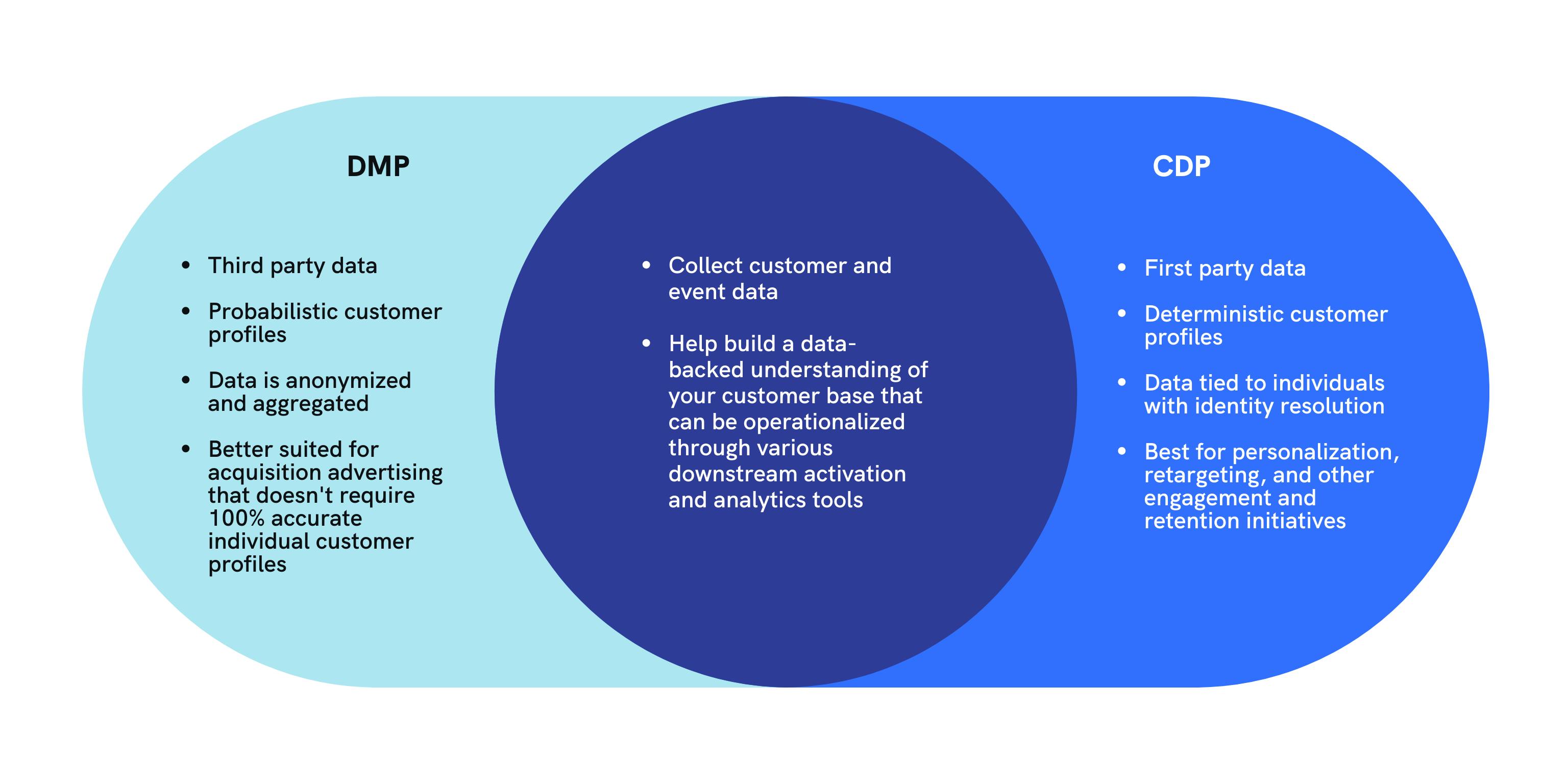CDP vs. DMP: What’s the difference and which one should you use?
Create a dynamic martech stack capable of collecting, transforming, and activating customer data by using a Customer Data Platform to augment your Data Management Platform. Learn how you can leverage these technologies to help you turn your customer data into a growth asset.
When it comes to collecting, organizing, and activating user data, many different solutions promise to help marketers achieve their goals. With so many options, it’s easy to implement a system that creates operational bottlenecks in the long-run.
The real challenge for marketers, therefore, is to discern which solution will best serve their business needs and support future requirements.
Many marketers we work with have used DMPs at some point. But now, they need a solution that can solve challenges related to collecting, organizing, and activating first-party customer data while also supporting data privacy.
This research process often leads marketers to ask: What’s the difference between a Data Management Platform (DMP) and a Customer Data Platform (CDP), and which is right for me?
To help you figure out the best option for you, this article will discuss:
- How CDPs and DMPs work
- How they differ from one another
- And how you can leverage them in tandem to help you turn customer data into a growth asset
What is a DMP and what can it do?
As Gartner explains it: “A data management platform is software that controls the flow of data in and out of an organization. It supports data-driven ad strategies, such as segmentation.”
DMPs have been around for a long time—and they’ve historically given brands access to customer data that’s otherwise inaccessible and/or siloed.
DMPs serve 3 main roles:
- Data collection
- Segmentation
- Measurement and adjustment
Data collection
DMPs consolidate data from cross-device touchpoints and tie them to the customer profile they most likely belong to using a predictive algorithm. The benefit of this is two-fold: you don’t have to gather personally identifiable information (PII) from customers at every interaction and you can scale your database more quickly.
Some DMPs can collect and store some first- and second-party data—which is anonymized and hashed before being stored and organized for use by brands—but DMPs mainly rely on third-party data to create audiences.
They gather data in three ways:
1. Onboarding
This is a largely manual process where customer information determined to be significant is put together into a CSV file, then fed into a DMP.
These files usually include fields like attributes, attribute IDs, attribute types, banding rules, and a description. Attributes are aspects that can be attached to people, like age or gender or whether they signed up for a loyalty program. These then have attached attribute IDs and attribute types to help keep the information organized, with banding rules helping to define the attribute value further.
Descriptions are put in place as a reminder to teams as to the source, value, or importance of that information. Once onboarded, all of this data is then stored for future use.
2. Tags or cookies
DMPs collect anonymized, hashed customer information through embedded code in websites, mobile sites, and mobile apps. Tags perform specific tasks—like recommending products or chatting with customers—while collecting behavioral data on each customer.
Cookies and tags are efficient collectors of customer data, but they are limited to digital properties where the tags can be triggered. Tags also have an expiration date and so are ephemeral data sources.
3. APIs
DMPs can also collect formatted data objects from other platforms or services a company may be using to manage customer data through a server-to-server exchange.
Segmentation
DMPs take all that data and create audiences full of anonymized proxies with similar characteristics, depending on what kind of audience a marketer is trying to target. Marketers can then take these audiences and feed them into their demand-side platform (DSP) to support ad buying.
Measurement and adjustment
Finally, a DMP manages campaign activity and audience data and measures them to help optimize ongoing campaigns as well as establish best practices for future campaigns.
The right tool for the right job
DMPs are very useful, particularly for marketers looking to acquire new customers through advertising.
But, for all they do well, DMPs do have some shortcomings.
The reality is both consumers and the technology available to brands have changed since DMPs rose to prominence.
Governmental regulations (like GDPR and CCPA/CPRA) and growing concerns about privacy and data ethics on the part of consumers have made third-party cookies less available. That’s why it’s crucial today for brands to cultivate and harness first- and second-party customer data.
Beyond that, rising ad and other customer acquisition costs mean companies need to focus on retention and lifetime value (LTV) more than ever—and holistic and trustworthy customer profiles are the crux of that effort.
Because data in the DMP is aggregated and anonymized, you can’t build these comprehensive customer profiles with a DMP. DMPs use probabilistic matching to build profiles, so they aren’t 100% accurate. For large scale ad campaigns, they’ll do the trick—but you can’t use them for 1-to-1 personalization, for example.
So for brands focused on 1:1 personalization, engagement and retention, in addition to acquisition, a DMP is an incomplete solution.
To build comprehensive and reliable customer profiles, you need a Customer Data Platform.
What is a CDP and how can it help?
CDPs provide marketers with a single platform from which to collect, manage, transform, and activate all customer data, regardless of the source.
The biggest difference between a CDP versus DMP comes down to the kind of data they collect. CDPs use first-party data to unify touchpoints and match them to deterministic customer profiles.
Marketers and other teams can then pipe that data into other systems like ad platforms, product and customer journey analytics software, CRM tools, and more.
Data collection, quality protection, and governance
As we mentioned above, CDPs collect first-party data (such as email addresses, device IDs, and behavioral data) in real time through packaged APIs and/or SDKs. That means 3 things for brands:
- Instead of relying on third-party cookies, you can build your own walled garden of high-quality first-party data.
- Individual-level behavioral data can be accessed on deterministic customer profiles
- Greater control over data governance and data quality management
With a CDP, you determine which data gets collected and how long it’s stored—and you can service data erasure requests at any time. Plus, certain CDPs (like mParticle) set rigorous data security standards to ensure your data is collected in a way that complies with privacy regulations and legal requirements.
Profile unification and identity resolution
Centralizing first-party data collection with a CDP allows you to build holistic, individualized customer profiles that:
- Encompass every touchpoint, across devices, channels, and time
- Include data from throughout the customer journey
- Power individual-level personalization (instead of persona-level personalization)
Customer data collected by a CDP is attributed to a persistent profile. Profiles can inform future interactions based on that specific customer’s history.
Whereas DMPs tend to retain data for only a short amount of time (say, 90 days or so), CDPs retain it for much longer. That means your customer profiles get more detailed and robust over time, as customers continually interact with your brand.
Additionally, certain CDPs merge anonymous and known activity to a single profile once a user converts, allowing you to gain a complete view of the customer journey
Segmentation
DMP audiences and segments are built for advertising and tend to follow a rigid structure. Audiences created in a CDP, on the other hand, are highly customizable, allowing marketers to hone in on precisely which customers they need to target, even down to the individual level.
In a few clicks, marketers can define custom audiences based on a high-quality, cross-channel data set. Segments can be created based on behavioral data, purchase intent signals, predicted order value, lifetime value, and more.
Data integration and activation
Once you’ve created these audience segments, you can forward them—along with your event data—directly to any number of downstream tools. Those can include, among others:
- Ad platforms like Google Ads and Facebook
- Other marketing tools for email marketing, push and SMS marketing, and more
- Analytics and Business Intelligence (BI) tools like Indicative or Tableau
- Customization and personalization software
- Even customer service and chat solutions
That means you can build an audience once, then operationalize it across all the other tools and systems in your stack. Plus, with pre-built integrations, this process is often super quick, with little to no data team resources required.

Together in perfect harmony
If you already have a DMP in place, here’s our advice: don’t think of it as CDP vs. DMP.
Adding a CDP to your stack—in addition—can help amplify the benefits of your DMP—as well as addressing some of the gaps in data persistence, identity resolution, data activation and acquisition—powering customer engagement and retention use cases.
If you don’t have a DMP in your stack, implementing a CDP can offer you all the same benefits and then some.
For an example, check out this article on how you can use mParticle and Adobe Audience Manager to deliver contextual marketing at scale.




